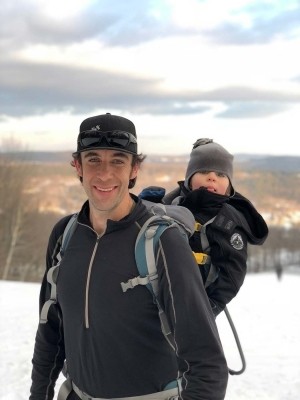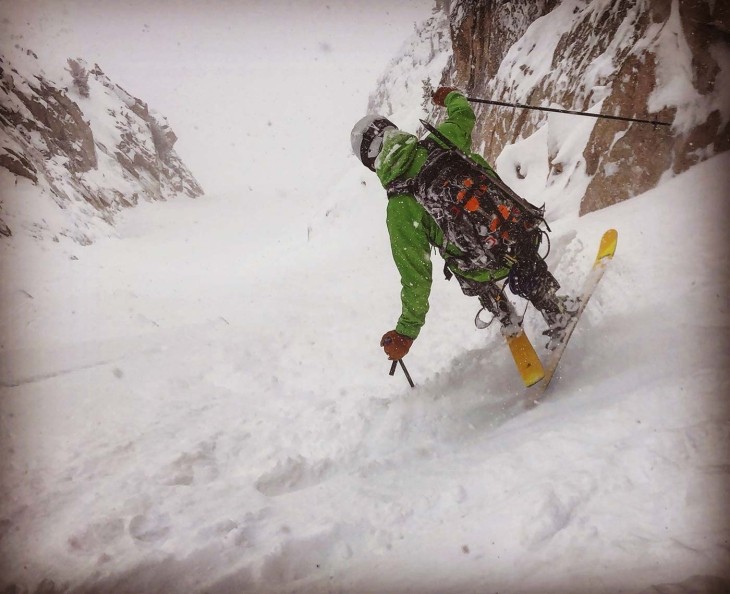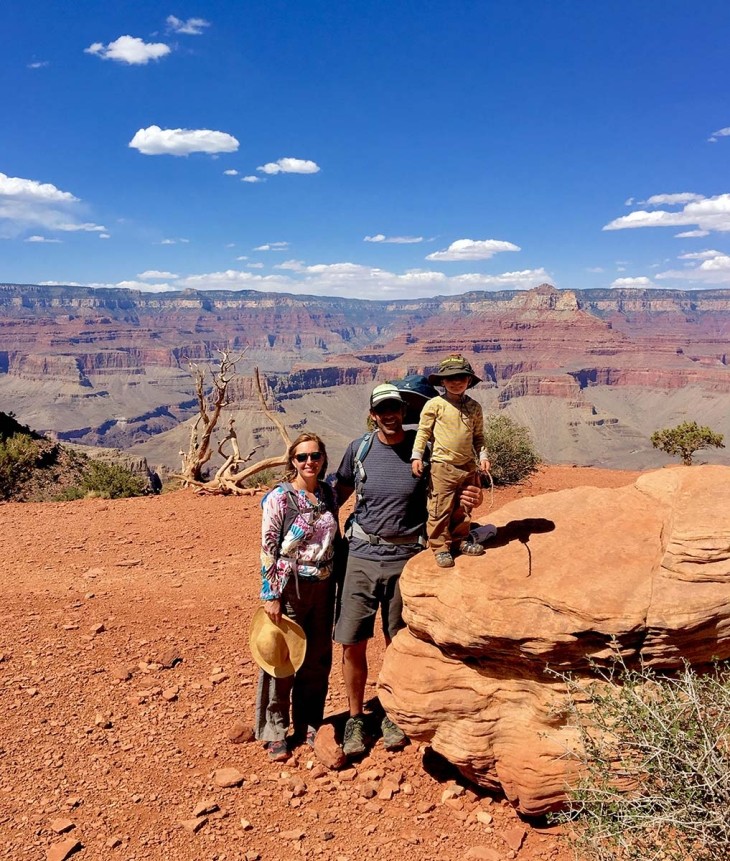
Zac Freeman grew up roaming the woods of central Vermont by bike and ski. After a post-high school stint in Utah and Colorado, he returned home to Braintree and worked with his parents as a jeweler in the family business. In 2013, he was a founding member of RASTA – the Rochester/Randolph Area Sports Trail Alliance – and now works as a trail builder, consultant, and advocate for outdoor recreation in the state. He and his wife, Shannon, live in a timber frame house they’ve built mostly on their own over the years, and have a 5-year-old son, Asher. They live within skiing – or biking – distance from the house where Zac grew up, and where his parents still live.
I was born and raised in Vermont, right here in the Braintree-Randolph area. I was outside all the time as a kid. We had some great hills behind our house, so I spent a lot of my time sliding on snow in the winter. Skiing clicked when I was 2 or 3 years old, skiing with my dad. It stuck. I remember idolizing Scot Schmidt, Glen Plake, and Mike Hattrup and all those guys in neon in the late ’80s. Skiing and biking are still the two main things that I do. I still ride snowmobiles, dirt bikes, and that kind of stuff, but at the core of it, it’s two wheels or two skis.
I would take my dad’s old frame backpack when I was 15 or 16 years old and strap my 205 cm slalom skis to it and I’d trek around in the woods and find little lines to ski. I’ve been skiing in the backcountry for 30-ish years. In the summers, I built single track trails on my folks’ land and the neighbors’ to ride mountain bikes on. We had an early thriving mountain bike scene in Randolph in the early and mid-90s. I was a young kid helping promote and build trails. It was a fun life. We didn’t have cable TV, and obviously there were no cell phones. It was great to grow up in that age of not many screens around.
I graduated high school in 1995 and I went straight to Alta, Utah. It snowed I think 680 inches that year. There was one two-week stretch where it snowed literally every day. It completely blew my mind. I lived up on the mountain. It was a super small ski area, not much going on, except amazing skiing! Salt Lake City was nearby, but I wanted more of a community. I grew up in a small town, and at the end of that year, I was looking for that small town setting. I had a couple of friends and a cousin who had moved to Crested Butte, Colorado, and I went to see them. I instantly fell in love with the town. The mountains, the community, the location – that was what I was trying to find. So I packed up and moved. After many amazing years living and exploring the west, I felt the draw to go home.
I moved back to Vermont in 2003 and bought some land that was surrounded by conserved Vermont Land Trust land, up the hill from where I grew up. From my deck, I can see the Franconia Ridge, Moosilauke, Smarts Mountain to the east and the Green Mountains to the west. I was young, but I knew I couldn’t pass it up. I scrounged together some money, I borrowed a little from my parents, I liquidated a couple of assets – a 4-wheeler and a couple of other toys – to come up with the money to buy the land. It was meant to be, and I needed to stay right here. My true home.
We started RASTA at the end of 2013. We wanted to create opportunity to get a little bit more traffic in small communities that are trying to figure out a way to be more viable and create a little economic development, as well as create more opportunity for skiing and biking where there really wasn’t any before. Angus McCusker and I, along with a handful of others, are the founding members and have helped grow the club into what it is today. Our club is pretty much split 50/50 between summer and winter. We have two backcountry ski zones with glades, in Braintree and Brandon Gap. And we’ve developed mountain biking trail networks here in Randolph, over in Rochester, and Green Mountain Trails down in Pittsfield, Vermont.
The backcountry zones that we made had no skiing there prior to our efforts. So we didn’t just take a stash and hang up some signs and blow it up. We went in and worked with the foresters, either on NEFF [New England Forestry Foundation] land or on U.S. Forest Service land. We went through all the environmental reviews, and we followed all the regulations, and we created brand new backcountry ski zones where there weren’t zones before. Call it trailblazing or whatever, they were first-of-their-kind in the nation.
We had no idea that what we were doing was going to be the beginning of this big boom. RASTA is a real leader, but that wasn’t our objective starting out. We just wanted to create some great skiing for the people who live here, and for people who wanted to come in from elsewhere. And that obviously has grown exponentially. These zones aren’t for everybody. Some people say it’s not backcountry skiing, more like a ski resort. And I get it. There’s a trail map and trails and signage. It’s not total wilderness backcountry skiing. We’re not trying to make it that. We’re not saying it is. This is a whole new sport in a way, with these structured backcountry ski zones. It’s the evolution of backcountry skiing.
I worked as a goldsmith in the family jewelry business until 3 years ago. Then I turned my life-long passion for building mountain bike trails and community development into a career. I’m a trail builder, consultant, advocate for outdoor recreation here in Randolph, and I’m involved on the state level with the Vermont Outdoor Recreation Economic Collaborative (VOREC). I bought a mini excavator last year, and we’re starting to build more machine-built trails around here. We’ve working on a building a bike park/skills park in Randolph this year. And there’s the Velomont Trail coming through this area. That’s a proposed single-track trail that will connect a number of mountain bike networks and run the length of Vermont, from Canada to Massachusetts. It’s going to be a hut-to-hut trail, kind of like the Long Trail [hiking] or the Catamount Trail [cross-country skiing]. Lately I’m doing more work with the Velomont team in my region, landowner negotiations, along with municipal and state proposals – and also executing some of the trail construction. This is a legacy project that will be used for years to come.
This year has just seen explosion of people wanting to get onto the trails everywhere. There’s no silver bullet that’s going to fix all the challenges of that huge growth, which is in part due to the pandemic. Education is one of the big things. But the education component is voluntary. If people don’t want to read it, listen to it, and understand it, they’re going to blow it off and keep going. There’s a lot of people out there who do the right thing, who play by the rules. There’s also a bunch of people who are either new to the sport or just don’t care as much. That is the demographic we are trying to reach. I think there is a need for more education and improved signage and some blunt talk. If you park in front of the No Parking sign in the tow-away zone at a trailhead, you have made the choice to accept the consequences, so don’t get mad when your car is gone when you get back from skiing.
We as an organization have discussed “what is our capacity?” How many trails can we manage? How many people do we want going down that rural road to get to the trailhead? We don’t gain much by continuing to expand to accommodate more and more people. It’s actually quite the opposite – you gain more headaches. The capacity thing is a big deal. Education is a big thing. Maintaining solid landowner relationships is crucially important for current and future trail access.
There was an incident in the Braintree Mountain Forest a few weeks ago where a couple of skiers went off the trail and ended up on private property that was posted. The landowner was pretty upset. It’s a tricky situation up there, because if you look at our Braintree Mountain Forest map, you’ll see the landowner is directly in the center of a larger tract of land. He doesn’t ski. He just wants his privacy, and I really respect that. I’ve been friends with him for a long time, and I continue to work with him to help retain his privacy.
We immediately shut those trails down, and we worked on a trail reroute and got that cut and it goes far away from the landowner’s house. We’ve closed some of the other existing trails that go very close to his land. We’ve added more signage and created a quiet zone trailhead and a quiet zone access trail. We’ve posted his land for him. I am proud of the work RASTA has done to protect landowners’ privacy. It’s unfortunate that this had to happen, but I think it’s a really good opportunity to use as an example of what can happen because of your actions. This privilege can be taken away in a heartbeat. We need to be a little quieter and more respectful of nature and surrounding landowners. We can drive a little slower on the roads to get to the trailheads. We just need to be more conscious of our impact on trails and the surrounding areas and not take it for granted.
The skier who died in an avalanche on Mount Washington last month was a friend of mine, Ian Forgays. Ian is from Vermont and was a pretty large figure here in the ski community, and he’ll be sorely missed by many. He’s an expert skier who has logged hundreds of days up there at Mount Washington over the years. He’s just the type who would get up at 4 in the morning and get to the trailhead by 7 and ski a whole day and drive home. It’s been a bad winter for avalanches all over the country.
It definitely makes you reevaluate stuff, reevaluate the risk. It changes your perspective a little bit on life. I’ve been caught in smaller slides. I’ve lost friends in other slides. You do all your homework, but it is that risk versus reward balance that you always are struggling to find. And accidents like this force you to reflect on your own choices. The more that you’re out there, the risk goes up. You can have all the avalanche classes, and time on the mountain and all that, but there’s that big variable that you don’t really know when it’s going to rip loose.
When I was younger, I got rowdy in the mountains. I still do. I still get that itch. Last winter I took a trip to ski in the Sawtooth Wilderness in Idaho. I skied some of the crazier lines that I’ve ever skied in my life, with fellow backcountry advocate Tyler Ray. We skied the Sickle, a classic 2000-foot couloir with massive rock walls and a near 60-degree pitch at the top. That was one of those crazy 7,000-vert, 12-hour ski days. That’s the adrenaline junkie side of me, and I’ll always have that. But I’m balancing that out a little bit more in my life.
I love to just go tromp around in the woods and look at cool terrain features, track some wildlife, check out the diverse timber stands. That’s me being at ease in the woods. It’s not going to crank out a 5,000-vert day, going hard lap after lap. That’s a whole separate mindset. Tapping into nature, slowing down a little bit, bringing a nice lunch, hanging out and enjoying where you live and really respecting it – that’s my sweet spot.
I’m almost 44, and the older I get, what makes me happy in life has changed. I’m not slowing down, but now, if I go out on a bike ride with my son, I’m forced to view life through a 5-year-old’s eyes – it’s so much fun. That fills me up. My son has also helped shape my vision for what I’d like to see in our community. I want to make the town I was born and raised in better through events, more trails, more recreational opportunity and bringing people together around it all. Our community has responded with enthusiastic joy. It has truly been the most fulfilling work I have ever done.




